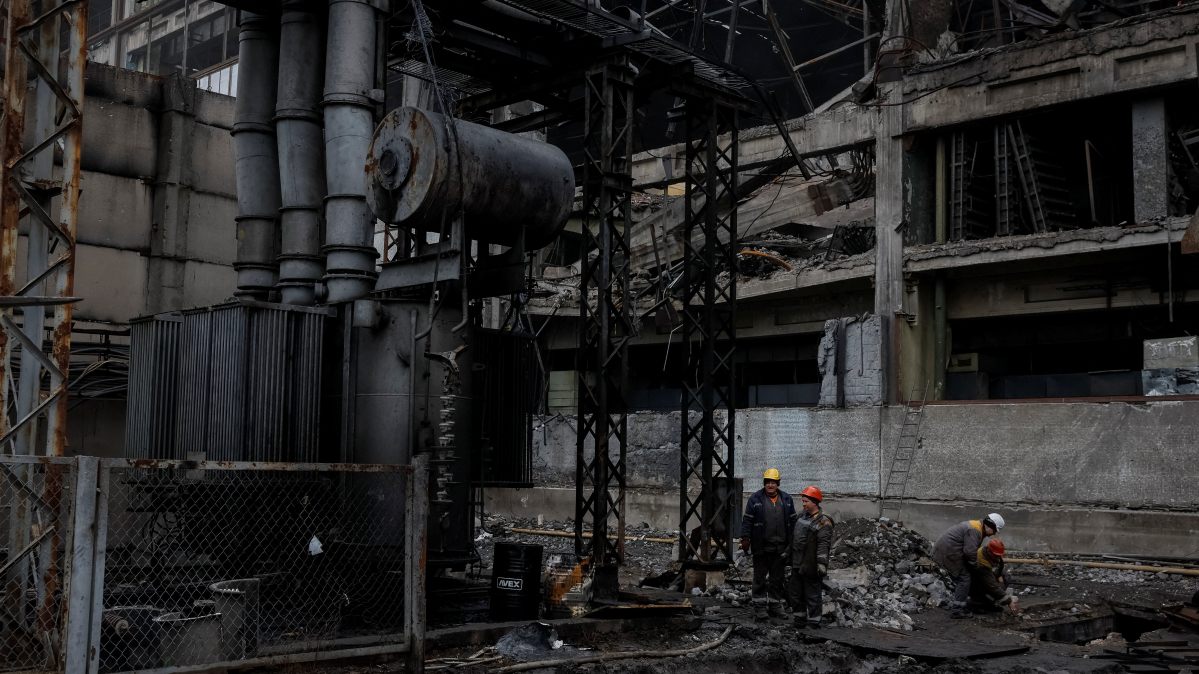International Robot Exhibition draws visitors in Tokyo
The International Robot Exhibition (IREX) opened in Tokyo on 3 December, bringing together visitors to explore robotics applications for industry, hea...

Standing beside the damaged exterior of his thermal power plant, 53-year-old production manager Oleksandr reflected on the all-too-familiar reality for Ukrainian energy workers: quickly repairing the facility amidst yet another wave of intense Russian air strikes.
“We could have done without this experience in a civilian job, but we’ve had no choice but to gain it,” said Oleksandr, who was only authorised to give his first name.
Inside the vast plant, twisted metal protruded into the open sky, and the smell of burnt equipment lingered in the air following what employees described as the largest Russian drone and missile attack yet.
The media were allowed to view the plant, but under strict conditions not to reveal its location or discuss specific damages for security reasons.
Facilities like this one have been repeatedly targeted in Russia’s ongoing efforts to destroy Ukraine’s energy infrastructure and erode its resolve to continue fighting in the war.
As the conflict nears its fourth winter, Russia has intensified its attacks on power generation, electricity transmission systems, and gas production facilities.
These strikes have plunged the population into familiar spells of darkness and cold, while energy workers are forced into a relentless routine of restoring equipment ahead of the next assault.
In the latest wave of attacks, at least eight people were killed on Friday in overnight strikes on Kyiv and the southern Odesa region, according to local authorities. President Volodymyr Zelenskyy stated that the attack involved around 430 drones and 18 missiles. Vast facilities under severe assault
The growing frequency and precision of these strikes have raised concerns that this winter will be especially challenging, as the war marks its fourth year and Ukrainian troops, outnumbered, struggle to repel Russian forces on the frontlines.
The sound of welding echoed as workers cleared rubble from the plant. Outside, one employee carried a twisted piece of a Russian drone.
The strain is evident on the soiled faces of the plant’s workers, who nevertheless manage to find moments of camaraderie, even sharing laughter during cigarette breaks. Volodymyr, a 53-year-old shift manager, said his team has learned to stick together, often resorting to dark humour. Maintaining morale amidst the chaos
Evacuation plans are followed closely — except by those on Volodymyr’s team, who are responsible for keeping the systems operational during attacks.
“I think my guys are superheroes,” he said, recalling the most recent strike. “They stayed united, did their jobs, and supported one another.” As he spoke, a black-and-white cat — a survivor of multiple strikes — slinked across a pile of sandbags behind him.
“She has her own evacuation route, as you can see,” he added, smiling.
One of the biggest challenges, according to Oleksandr, is preventing the facility's sprawling network of massive pipes from freezing.
“Each time, we do this work faster, rebuild, and develop new methods to survive,” he said.
For nearly three decades following the dissolution of the Soviet Union, the international system was defined by a singular, overwhelming reality: American unipolarity.
Chinese scientists have unveiled a new gene-editing therapy that they say could lead to a functional cure for HIV, making it one of the most promising developments in decades of global research.
Faced with mounting public outrage following one of the deadliest environmental disasters in the nation’s recent history, the Indonesian government has pledged to investigate and potentially shut down mining operations found to have contributed to the catastrophic flooding on Sumatra.
Israel was cleared on Thursday to participate in the 2026 Eurovision Song Contest, a decision made by the organisers, the European Broadcasting Union (EBU), which sparked a major controversy.
Britain’s King Charles III welcomed German President Frank-Walter Steinmeier on Wednesday, marking the beginning of his three-day state visit to the United Kingdom. The visit, the first by a German President to the UK in 27 years, comes as the two countries continue to strengthen ties post-Brexit.
A record-breaking flotilla of Chinese warships and coast guard vessels has surged into strategic waterways across East Asia this week, triggering high-level alarms in Taipei and Tokyo as regional powers grapple with Beijing’s largest-ever maritime projection of force.
Former EU foreign policy chief Federica Mogherini has resigned as rector of the College of Europe amidst an ongoing fraud investigation, according to a statement released on Thursday.
Start your day informed with AnewZ Morning Brief: here are the top news stories for the 5th of December, covering the latest developments you need to know.
The United States plans to extend its travel ban to over 30 countries, U.S. Homeland Security Secretary Kristi Noem announced on Thursday.
Chinese President Xi Jinping accompanied French President Emmanuel Macron to Chengdu on Friday, a rare gesture seemingly reserved for the leader of Europe’s second-largest economy, highlighting Beijing’s strategic focus on Paris in its dealings with the European Union.
You can download the AnewZ application from Play Store and the App Store.

What is your opinion on this topic?
Leave the first comment